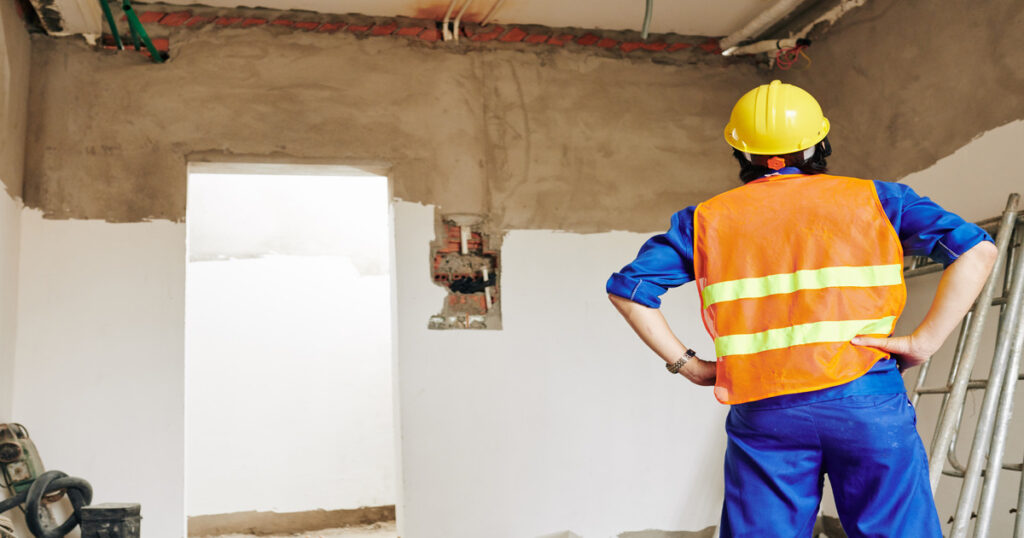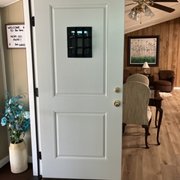In any home renovation endeavor, a defined scope of work is the structural foundation that ensures project success. Just as a blueprint outlines the architectural intricacies of a building, a scope of work document serves as the roadmap guiding all stakeholders—from homeowners to contractors—through each phase of the project.
This blog helps set clear expectations and provides a budgeting, scheduling, and resource allocation framework. The absence of a well-thought-out scope can result in costly misunderstandings, project delays, and, ultimately, dissatisfaction with the final output.

What is “Scope of Work“?
A Scope of Work (SOW) is a formal document that captures a project’s goals, tasks, deliverables, timelines, and resources. It functions as an agreement between parties that details the work to be undertaken and how it will be conducted.
Why it Matters in Home Renovation
Regarding home renovation projects, the SOW becomes an indispensable guide for orchestrating complex, interconnected activities. Whether you are refitting a bathroom or adding an entirely new wing to your home, each action, material, and hour of labor must align precisely with the overall plan. A well-constructed SOW is your lighthouse, steering you clear of the treacherous waters of scope creep, budget overflows, and unwarranted delays. It ensures every stakeholder—be it your architect, contractor, or even family members—understands their roles, responsibilities, and deadlines.
Components of a Good Scope of Work
Project Objectives: Clear, measurable goals that align with your vision.
Tasks or Deliverables: A breakdown of each task and its corresponding deliverable.
Timelines and Milestones: Specific dates for the commencement and completion of project phases and intermediate milestones.
Required Resources: Lists of materials, labor, and equipment needed.
Budget Estimates: An itemized financial plan covering expected and contingency costs.
Risks and Assumptions: Potential challenges and underlying assumptions may affect the project.
Preparing to Define Your Scope
Conduct a Preliminary Assessment
Before creating your Scope of Work (SOW), a preliminary assessment is akin to laying the foundation for a building. Conduct a walk-through of the space you intend to renovate during this stage and jot down initial ideas and requirements. Note structural elements that might influence your project, such as load-bearing walls or electrical systems. Photographs and measurements are valuable at this juncture, as they can be referenced when planning specifics later on.
Set Budget and Time Constraints
Next, financial and temporal boundaries must be set. Your budget should encompass material costs, labor, contractor fees, permits, and a contingency fund for unforeseen expenses. Be realistic yet flexible, understanding that most projects will inevitably face some form of budgetary stress. As for the time frame, develop a schedule that considers your availability, the project’s complexity, and any external factors like seasons, holidays, or community regulations. Time constraints aren’t merely deadlines but integral in phase planning and resource allocation.

Writing the Scope of Work Document
Project Objectives
Establishing project objectives is similar to setting the GPS coordinates for your renovation journey. Articulated objectives guide the entire project and ensure all stakeholders are aligned. Whether aiming for a more functional kitchen or an energy-efficient home, your objectives should be specific, measurable, achievable, relevant, and time-bound (SMART). This clarity sets the tone for the remaining components of your Scope of Work (SOW).
Detailed Tasks or Deliverables
Once objectives are in place, the next step is to break them down into digestible, actionable tasks or deliverables. Each task should be described in enough detail to remove ambiguity, specifying what needs to be done, by whom, and to what standard. Think of this as your project’s “building blocks,” where each task contributes directly to achieving your objectives.
Timelines and Milestones
A full SOW doesn’t merely state what needs to be done; it also outlines when tasks should be completed. Timelines provide structure, helping to manage dependencies between tasks. Milestones, conversely, are like checkpoints—significant events or stages that indicate progress. Both elements together act as the temporal backbone of your project, aiding in monitoring and control.
Required Resources and Materials
This section compiles a comprehensive list of resources necessary to complete the project. This includes tangible and intangible items—from building materials and specialized equipment to skilled labor and permits. The idea is to have a resource inventory at your fingertips, ensuring you’re fully equipped to execute the SOW.
Budget Estimates
A detailed financial plan is not just a wish list; it’s a strategic tool. It should align closely with the tasks and resources identified, providing an estimate for each line item. This section should also account for contingency funds for unexpected costs. Budget planning helps you avoid financial pitfalls and scope creep as a financial compass for your renovation voyage.
Risks and Assumptions
No project is without its set of risks and assumptions. While risks represent potential roadblocks, assumptions are the conditions expected to hold for the project to proceed smoothly. Identifying both allows you to prepare mitigation or contingency plans, adding a layer of resilience to your SOW.
How to Involve Stakeholders
Discussing with Family Members
Involving family members in the planning process is courteous and strategic. After all, a home renovation impacts everyone who lives there. Gathering opinions and preferences and assessing each family member’s practical needs is important. Think of this as internal market research; understanding the needs and wishes of those most closely impacted by the project helps refine the Scope of Work to be more inclusive and well-rounded.
Coordinating with Contractors
Good communication with contractors can be likened to a well-oiled machine—necessary for smooth operation. Contractors bring a wealth of practical knowledge and technical expertise to the table. Regular coordination helps clarify expectations, manage unforeseen changes, and ensure the project stays aligned with the defined Scope of Work. Effective collaboration can range from weekly update meetings to a shared digital platform where tasks, timelines, and milestones are tracked.
Keeping Neighbors in the Loop
While neighbors may not have a direct stake in your renovation, keeping them informed is both a courtesy and a preemptive strategy for managing potential disruptions. A little heads-up can go a long way in maintaining good neighborly relations, whether it’s noise, limited street parking, or other minor inconveniences. Moreover, certain renovations may require permits that involve informing or obtaining approval from neighbors, making their early involvement beneficial.

Common Mistakes to Avoid
Underestimating Costs
One of the most frequent pitfalls in home renovation is underestimating costs. Many homeowners approach their budget optimistically, only to find that real-world expenses far exceed their estimates. This discrepancy often leads to compromised quality, halted work, or unfinished projects. To mitigate this risk, adopt a conservative approach to budgeting and include a contingency fund to cover unforeseen expenses. Think of this as your financial safety net; it provides a buffer that allows your project to proceed smoothly, even when unexpected costs arise.
Overlooking Important Details
During home renovation, the devil is indeed in the details. Neglecting small yet critical elements like finishes, fixtures, or even the orientation of a room can lead to dissatisfaction with the final product. These minor oversights can cascade effects on related tasks, derailing your project timeline. Attend to every detail in your Scope of Work for a more fulfilling result.
Not Securing Necessary Permits
Skipping the permit process is like playing Russian roulette with your project’s legality and safety. Without the proper permits, you risk fines, legal issues, and the possibility of undoing completed work. Permits are not bureaucratic hurdles; they’re quality and safety checks that benefit you in the long run. The permitting process often involves inspections that can catch issues before they become big problems, thus adding another layer of assurance to your project.
Revising and Updating the Scope
When to Revise
Even the best-laid plans may require adjustments; your Scope of Work (SOW) is no exception. Revision is often needed when encountering unexpected challenges, significant changes in budget, or alterations in design preferences. Think of your SOW as a living document, similar to a garden that might need pruning or additional plants to reach its full potential. Timing is key here; revising too often can create project instability, while never revising can lead to inaccuracy and potential failure.
How to Update the Document
To effectively update your SOW, treat each revision as a mini-project cycle: assess the situation, discuss changes with stakeholders, amend the relevant sections, and update timelines and budgets accordingly. The updated document should replace the old version with a change log detailing what was altered, why, and who approved the changes. This meticulous approach to updating ensures that nothing falls through the cracks and that all stakeholders are kept in the loop.
Communication Best Practices
Transparent and frequent communication is the adhesive that binds all elements of a successful project. When a revision is needed, communicate openly with all involved parties. The method of communication—whether via formal meetings, email updates, or a project management platform—should be consistent and agreed upon by all. Keep the lines of dialogue open, and make sure all stakeholders have an opportunity to weigh in on revisions to the SOW. Effective communication is like the central nervous system of a project, transmitting vital information to all parts to ensure coordinated action.
Writing the Scope of Work
A robust Scope of Work is the backbone of a successful home renovation, offering clarity, focus, and a framework for accountability. It aids in resource allocation, timeline management, and stakeholder engagement, reducing the likelihood of surprises that can inflate costs or delay completion. Ultimately, a well-crafted SOW is your best ally in ensuring that your renovation project is efficient and aligned with your vision.



























